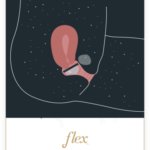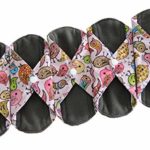Postpartum Pelvic Floor – Inflammation

In the final part of my series of three posts on the postpartum pelvic floor, I want to write about inflammation. In the words of the women who suggested this topic to me, “YOUR LADY PARTS WILL BE SWOLLEN LIKE A MARINATED GRAPE!” If that puts things too delicately for you, I will just say that it is to be expected that, regardless of tearing or not, you will be very sore in your perineum after delivering a baby.
To review what your perineum is, here is a great anatomy resource that teaches you all about it. Your perineum is basically the tendon, muscles, skin, and fascia surrounding the opening of the vagina back to the anus. If you couldn’t already guess, this tissue all goes through quite a bit during the labor and delivery process! In many cases, you may even have perineal tearing, which I talk more about here.
For women that deliver vaginally, most of this perineal tissue gets quite stretched out to accommodate the biggest part of the baby’s head or shoulders. Even for women that have c-sections, the perineum can go through quite a bit of trauma; often before having the surgical delivery, a woman may labor for hours and have a lot of the same changes to the lower pelvic tissue as a woman that ends up delivering vaginally.
The Typical Healing Process
So what can you expect in the healing process? Is it going to be like this forever?! For me, there seemed to be no relief to feeling swollen (like a marinated grape) in those first few weeks. But there was actually a lot going on during that time. Let’s look at the typical tissue-healing timeline.

After childbirth, it may take the muscles and tendons up to 6 months to heal, while the ligaments could take even longer. But those first few weeks are critical in the healing process. Initially, there may be a lot of inflammation as you get increased blood flow to the tissues to bring the cells responsible for cleaning up the dead tissue and then eventually laying down new tissue in the area. We want to interfere in this healing process as little as possible to optimize how the tissue heals.
So Should I Use Ice or Heat?
I jumped on the creative pinterest idea to make homemade “padsicles” for my postpartum recovery, like many other women I know. You have likely seen it. You combine aloe vera gel, witch hazel, and maybe some essential oils on a heavy overnight menstrual pad and then freeze it to be worn later. Sounds brilliant, right? The soothing, cool pad seems like a cheap and easy way to prepare for some self-care for after delivery. It is true that ice can be beneficial in reducing pain and decreasing inflammation, so it is recommended for right after delivery to stick an ice pack on the perineum. But after that initial relief, you really ought to let the inflammatory process run its course in the tissue healing process. Prolonged icing will actually just slow down healing.
Bathtime!
After the initial 24 hours or so of icing for pain relief, then you should switch to heat to aid in healing. A simple way to do this is to take a bath or use a sitz bath with warm water and epsom salts if desired. Avoid anything too fragrant or oily. Remember, you probably wouldn’t clean off your scraped knee with apple kiwi strawberry something or other from Bath and Body Works. So don’t soak your healing perineum in it either.
Confession time: I HATED baths not too long ago. I know, it goes against every female stereotype. To me, they always seemed like too much of a hassle when a quick shower was an option. But I got into the habit of taking a 20 or 30 minutes bath after having my baby, and now I am hooked.
It seemed at first like a waste of precious sleep time to take a bath after she was already asleep in her crib. But that self-care time was just as precious as sleep was in those first few weeks. It was also a great way to put a lock and a door between me and the responsibility of motherhood or the temptation to take her out of everybody else’s arms. It became time where I could unwind and trust that somebody else was responsible for a little bit. See my post here on self-care postpartum. I also immediately began noticing a decrease in my pain in my perineum after I started regularly soaking.
How Much is Too Much Exercise?
While tissues are healing, you will feel inflamed. But you may also notice an increase in inflammation if you are “overdoing” it. It is hard to know where that line is between healthy return to activity and doing too much. Always start by following guidelines that your doctor gives you. For most women, that includes at least six weeks of “pelvic rest.”
Pelvic rest definitely means avoiding sex. But it also means being kind to your pelvic organs as they heal and return to their pre-pregnancy state by not immediately beginning activities that require a lot of jumping, running, bouncing, etc. Aggressive bearing down is also a no-no, which I address in my post about poop… because everybody does it. Heavy weight lifting often encourages the person to bear down and create abdominal pressure in the lifting motion. So maybe don’t jump right into Crossfit. I made the mistake of thinking that I was “healed enough” and returned to high-intensity activity before I was ready.
Look for the Signs.
You will know if you are doing too much by paying attention to how much bleeding you are seeing. You should basically have a steady decrease in bleeding after the delivery, so if you suddenly see an increase, or it goes on longer than a few weeks, talk to your doctor! You may feel inflammation or additional discomfort while sitting after too much activity. You will also see less serious, but equally important, symptoms like urinary leakage, if you are putting too much pressure on your pelvic floor muscles before they have healed. Take a hint from your body and back off a bit. And if things are not improving, talk to your doctor. Did I mention to talk to your doctor yet?
FYI, while some urinary leakage is considered normal in the first few weeks after delivery, it should resolve. If it does not, you may have stress incontinence. This is a condition that pelvic floor therapists treat very commonly! I talk about it more here. So get a referral or go directly to see your local pelvic health PT to get back to your normal. PLEASE, don’t wait 18 years until your child is off to college to decide it is time to take care of your own health.





